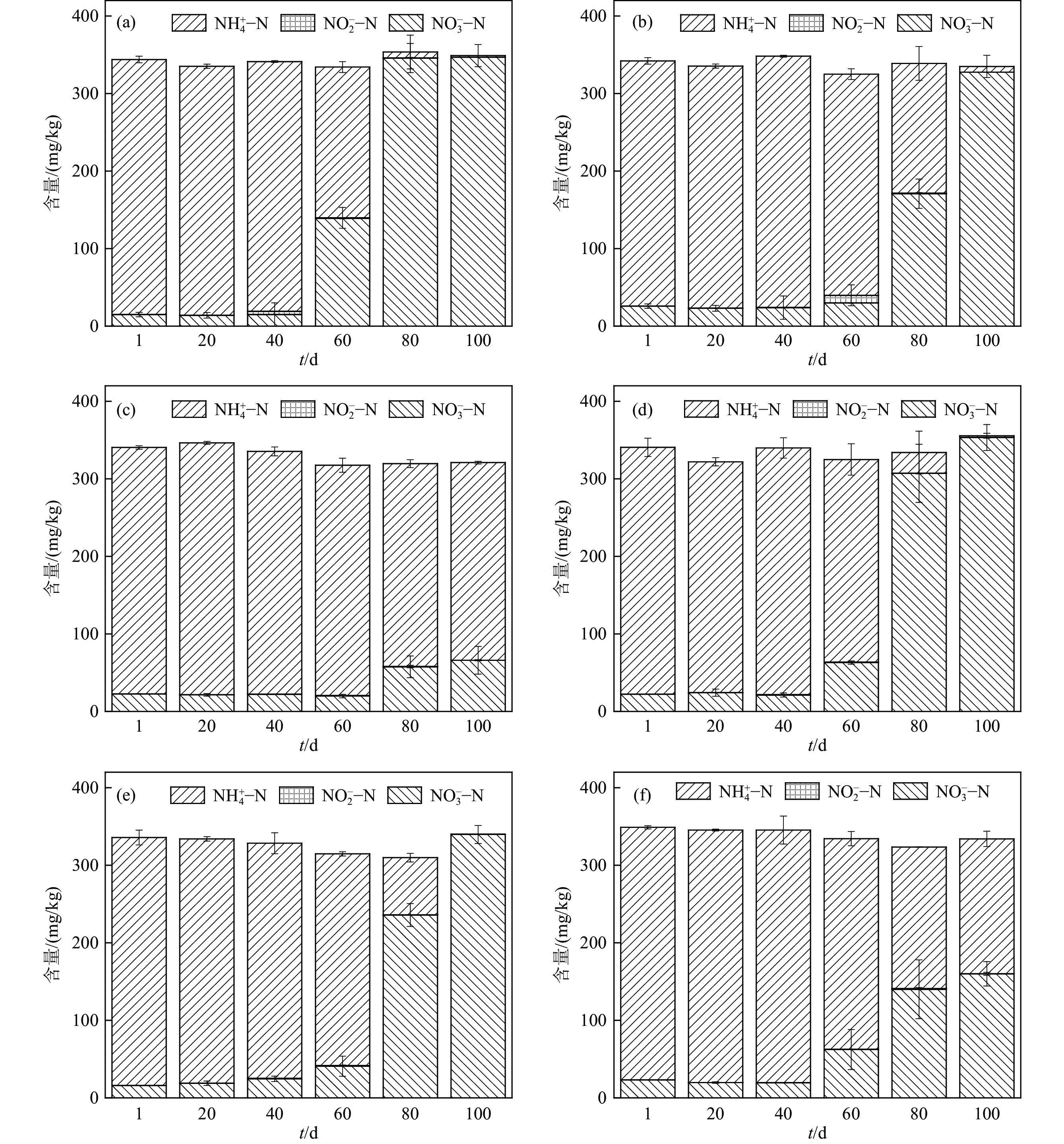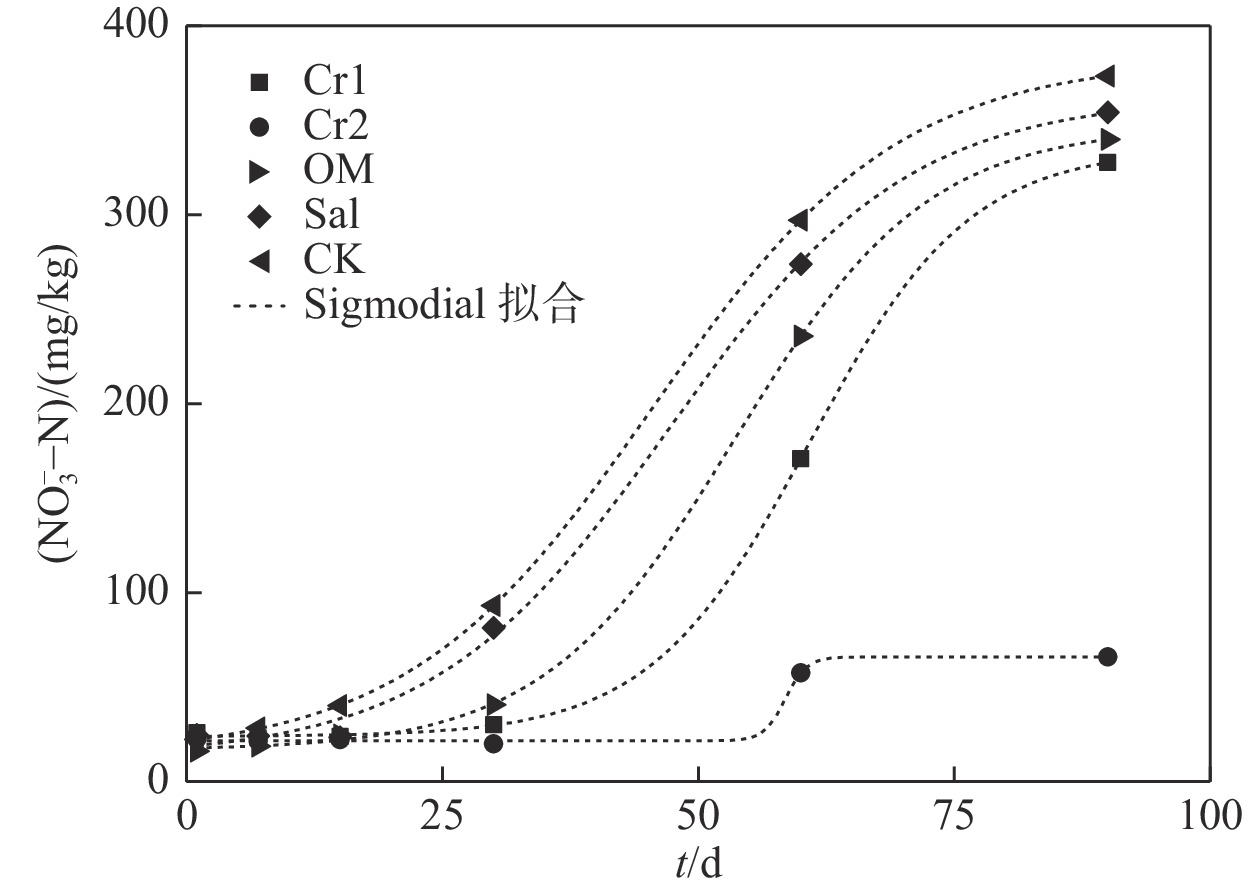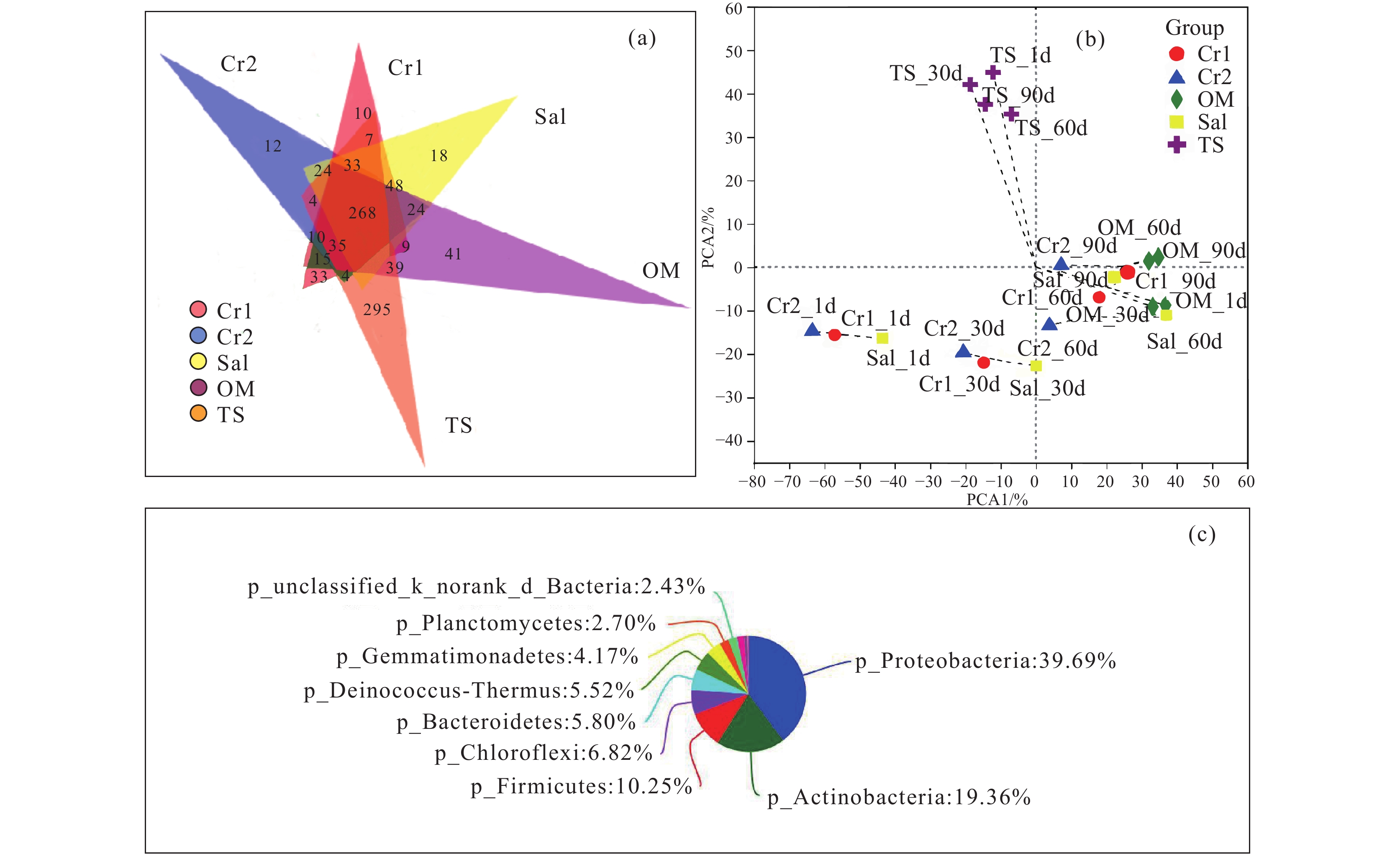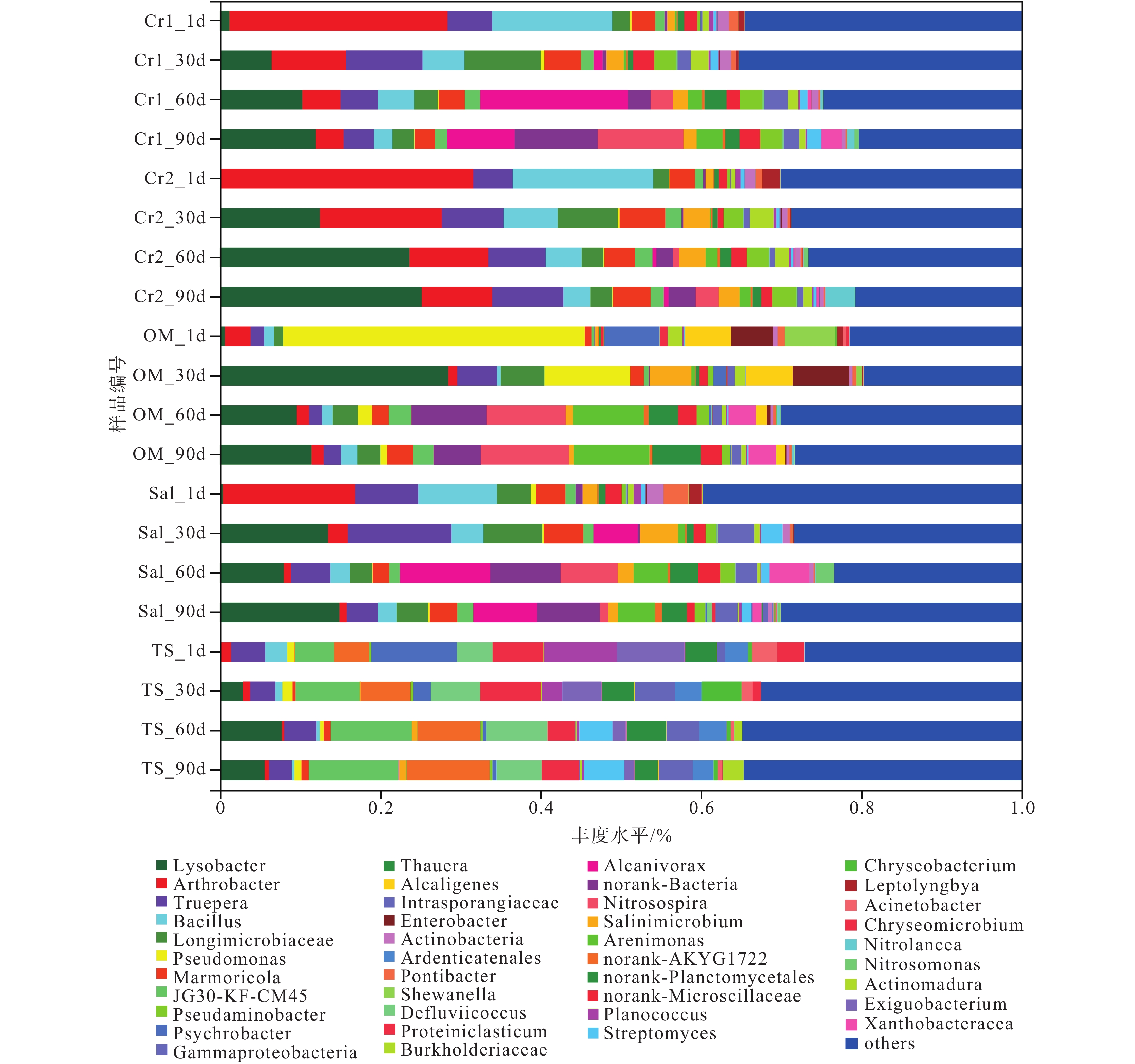Effects of characteristic pollutants in leather sludge leachate on soil ammonia nitrogen transformation and microbial community structures
-
摘要:
研究目的 查明制革污泥渗滤液中特征污染物(Cr(III)、盐分、有机质)对土壤NH4+−N转化和微生物群落结构的影响,为制革污泥的安全农用及土壤NH4+−N的污染防控提供理论依据。
研究方法 通过土壤培养实验,研究不同污染物影响下土壤中NH4+−N向NO3−−N的转化规律,并利用高通量测序对比分析不同条件下的微生物群落组成和结构变化特征。
研究结果 制革污泥渗滤液中特征污染组分对土壤中NH4+−N硝化过程的抑制程度排序为:Cr(III)>盐分>有机质。外源Cr(III)进入对土壤中NH4+−N的转化速率和转化量具有明显抑制作用,而土壤中盐分和有机质主要影响硝化作用的启动时间和降低硝化速率。随着土壤中Cr(III)含量由100 mg/kg增加到250 mg/kg,培养90 d后NH4+−N的转化量由94.23%降低到19.38%。高浓度Cr(III)和盐分在污染初期对土壤中微生物丰度和群落结构影响显著,随土壤老化过程中Cr(III)生物有效性降低及微生物适应性增强,不同污染特征土壤中微生物群落结构和组成逐渐趋同,硝化功能菌(Nitrosospira、Nitrosomonas和Nitrosospira)丰度增加明显。
结论 冗余(RDA)分析结果表明,影响制革污染土壤中微生物群落结构演变的主要特征因子是Cr(III)(R2=0.53,P<0.01)、NH4+−N(R2=0.59,P<0.005)和NO3−−N(R2=0.53,P<0.01)。
Abstract:This paper is the result of soil environmental survey engineering.
Objective The objective is to identify the impact of characteristic pollutants (Cr (III), salt, organic matter) in the leachate of tannery sludge on the conversion of soil NH4+−N conversion and microbial community structure. It provides a theoretical basis for the safe agricultural use of tannery sludge and soil pollution prevention and control.
Methods The transformation of NH4+−N to NO3−−N in soil was studied through soil cultivation experiments under different pollution conditions, and the high−throughput sequencing is used to analyze the composition and structure characteristics of microbial community in soil.
Results The characteristic pollution components in the tannery sludge leachate inhibit the nitrification process of NH4+−N in the soil, and the influence factors are sorted as follows: Cr(III)>saltness>organic matter. The exogenous Cr(III) pollution has a significant inhibitory effect on the transformation rate and amount of NH4+−N, whereas the saltness and organic matter only delay the start time of nitrification and reduce the nitrification rate in soil. With the increase of Cr(III) content from 100 mg/kg to 250 mg/kg, the transformation amount of NH4+−N decreases from 94.23% to 19.38% after 90 days of culture. The high Cr(III) and salinity in the leachate have a significant impact on the microbial community structure and distribution in the soil at the initial stage of pollution. With the decrease of the bioavailability of Cr(III) and the enhancement of microbial adaptation in soil aging process, the microbial community structure and composition in Cr(III), salinity, and organic matter contaminated soils become similar, and the abundances of nitrifying bacteria (Nitrosospira, Nitrosomonas and Nitrosospira) also have an obvious increase.
Conclusions The results of RDA analysis show that the main characteristic factors affecting the evolution of microbial community structure in tanning contaminated soil are: Cr(III) (R2=0.53, P<0.01), NH4+−N (R2=0.59, P<0.005) and NO3−−N(R2=0.53, P<0.01).
-

-
表 1 不同实验条件下土壤中污染组分含量
Table 1. Contents of contaminated components in soil under different experimental conditions
样品
分组NH4+−N/
(mg/kg)Cr(III)/
(mg/kg)含盐量/
(mg/kg)有机质/
%CK 320.5 66.8 717 0.14 Cr1 316.3 103.5 1450 0.16 Cr2 318.0 252.8 2070 0.17 OM 319.7 69.8 885 0.42 Sal 318.4 67.2 10250 0.17 TS 268.5 184.0 10200 0.34 -
[1] Cao X H, Guo J, Mao J D, Lan Y Q. 2011. Adsorption and mobility of Cr(III)–organic acid complexes in soils[J]. Journal of Hazardous Materials, 192(3): 1533−1538. doi: 10.1016/j.jhazmat.2011.06.076
[2] Caporaso J G, Kuczynski J, Stombaugh J, Bittinger K, Bushman F D, Costello E K, Fierer N, Antonio G P, Goodrich J K, Gordon J I, Huttley G A, Kelley S T, Knights D, Koenig J E, Ley R E, Lozupone C A, McDonald D, Muegge B D, Pirrung M, Reeder J, Sevinsky J R, Turnbaugh P J, Walters W A, Widmann J, Yatsunenko T, Zaneveld J, Knight R. 2010. QIIME allows analysis of high–throughput community sequencing data[J]. Nature Methods, 7(5): 335−336. doi: 10.1038/nmeth.f.303
[3] Chang Hao. 2014. Study on the Pyrolysis Process and Product Properties of Leather Sludge[D]. Xi'an: Shaanxi University of Science and Technology, 1−52 (in Chinese with English abstract).
[4] Daims H, Lücker S, Wagner M. 2016. A new perspective on microbes formerly known as nitrite–oxidizing bacteria[J]. Trends in Microbiology, 24(9): 699−712. doi: 10.1016/j.tim.2016.05.004
[5] Huang Xuefen, Meng Min, Xie Gang, Luo Yucheng, Li Lei, Wang Weisheng. 2017. Study on speciation distribution of Cr and reduction of Cr(Ⅵ) in tannery sludge[J]. Journal of Guangxi University (Natural Science Edition), 42(5): 1930−1936 (in Chinese with English abstract).
[6] Ke X B, Angel R, Lu Y H, Conrad R. 2013. Niche differentiation of ammonia oxidizers and nitrite oxidizers in rice paddy soil[J]. Environmental Microbiology, 15: 2275−2292. doi: 10.1111/1462-2920.12098
[7] Kong X K, Li C H, Wang P, Huang G X, Li Z T, Han Z T. 2019. Soil pollution characteristics and microbial responses in a vertical profile with long–term tannery sludge contamination in Hebei, China[J]. International Journal of Environmental Research and Public Health, 16(4): 563.
[8] Kong X K, Wang Y Y, Ma L S, Li H, Han Z T. 2022. Impact of δ–MnO2 on the chemical speciation and fractionation of Cr(III) in contaminated soils [J]. Environmental Science and Pollution Research, 29: 45328−45337.
[9] Lai Qiaohui, Zhang Hao, Liu Zhipeng. 2019. Characteristics of soil microbial community and their impact factors in different constructed wetlands with plant communities[J]. Research of Soil and Water Conservation, 26(5): 89−94,99 (in Chinese with English abstract).
[10] Li Juan, Uwaremwe Constantine, Leng Yan, Zhang Xiaohua, Li Shiweng, Chen Ximing. 2017. Progess on the study of biodegradation of organic pollutants and adsorption of heavy metals with arthrobacter strains[J]. Environmental Science & Technology, 40(10): 89−97 (in Chinese with English abstract).
[11] Li Meng. 2017. Effect of Combined Application of Manure with Nitrogen Fertilizer on the Diversity of Nitrifier in Installed Vegetable Fields[D]. Shenyang: Shenyang Agricultural University, 1–56 (in Chinese with English abstract).
[12] Liu Y C, Zhang Z J, Li Y S, Fei Y H. 2017. Response of soil microbial communities to roxarsone pollution along a concentration gradient[J]. Journal of Environmental Science & Health Part A Toxic/Hazardous Substances & Environmental Engineering, 52(9): 819−827.
[13] Lü Xiaoli, Liu Jingtao, Han Zhantao, Zhu Liang, Yang Mingnan, Li Haijun. 2021. Geochemical characteristics and driving factors of high–ammonium groundwater in the rapid urbanization of the Pearl River Delta[J]. Geology in China, 48(6): 1770−1780 (in Chinese with English abstract).
[14] Ma Hongrui, Wang Xiaorong, Niu Xiaojun, Li Guiju. 2004. Releases of Cr(Ⅲ) and nitrogen from contaminated soil with tannery sludge during organic matter mineralization[J]. Journal of Agro–Environment Science, 23(1): 136−139 (in Chinese with English abstract).
[15] Martines A M, Nogueira M A, Santos C A, Nakatani A S, Andrade C A, Coscione A R, Cantarella H, Sousa J P, Cardoso E J B N. 2010. Ammonia volatilization in soil treated with tannery sludge[J]. Bioresource Technology, 101(12): 4690−4696. doi: 10.1016/j.biortech.2010.01.104
[16] Nakatani A S, Martines A M, Nogueira M A, Fagotti D S L, Oliveira A G, Bini D, Sousa J P, Cardoso E J B N. 2011. Changes in the genetic structure of bacteria and microbial activity in an agricultural soil amended with tannery sludge[J]. Soil Biology and Biochemistry, 43(1): 106−114. doi: 10.1016/j.soilbio.2010.09.019
[17] Pang Yajie, Li Chunhui, Han Zhantao, Zhang Zhaoji, Kong Xiangke. 2024. Migration simulation and pollution assessment of Cr (III) and ammonia from tannery wastewater in typical vadose zone in North China Plain[J]. Geology in China, 51(4): 1280−1289(in Chinese with English abstract).
[18] Pantazopoulou E, Zouboulis A. 2018. Chemical toxicity and ecotoxicity evaluation of tannery sludge stabilized with ladle furnace slag[J]. Journal of Environmental Management, 216: 257−262. doi: 10.1016/j.jenvman.2017.03.077
[19] Polti M A, Aparicio J D, Benimeli C S, Amoroso M J. 2014. Simultaneous bioremediation of Cr(Ⅵ) and lindane in soil by actinobacteria[J]. International Biodeterioration & Biodegradation, 88: 48−55.
[20] Sabey B R, Frederick L R, Bartholomew W V. 1959. The formation of nitrate from ammonium mitrogen in soils: III Influence of temperature and initial population of nitrifying organisms on the maximum rate and delay period[J]. Soil Science Society of America, 23: 462−465. doi: 10.2136/sssaj1959.03615995002300060029x
[21] Schloss P D, Westcott S L, Ryabin T, Hall J R, Hartmann M, Hollister E B, Lesniewski R A, Oakley B B, Parks D H, Robinson C J, Sahl J W, Stres B, Thallinger G G, Van H D J, Weber C F. 2009. Introducing mothur: Open–source, platform–independent, community–supported software for describing and comparing microbial communities[J]. Applied & Environmental Microbiology, 75(23): 7537−7541.
[22] Solá M, Lovaisa N, Costa J, Benimeli C, Polti M, Alvarez, A. 2019. Multi–resistant plant growth–promoting actinobacteria and plant root exudates influence Cr(Ⅵ) and lindane dissipation[J]. Chemosphere, 222: 679−687. doi: 10.1016/j.chemosphere.2019.01.197
[23] Wang B Z, Zhao J, Guo Z Y, Ma J, Xu H, Jia Z J. 2015. Differential contributions of ammonia oxidizers and nitrite oxidizers to nitrification in four paddy soils[J]. The ISME Journal, 9: 1062−1075. doi: 10.1038/ismej.2014.194
[24] Wang Feng. 2006. Study on Function and Character of Nitrifying Bacteria in Sewage Treatment Processes[D]. Shanghai: Tongji University, 1–169 (in Chinese with English abstract).
[25] Wang Ya'nan. 2007. Effects of Different Nitrogen Application Rates on Ammonia–oxidizing Bacteria Community Structure in Paddy Soil[D]. Beijing: China Agricultural University, 1–59 (in Chinese with English abstract).
[26] Xu Ke, Chen Honghan. 2011. Progesson three forms of nitrogen contaminant transport and transform in groundwater[J]. China Population, Resources and Environment, 21(12): 421–424 (in Chinese with English abstract).
[27] Yu Hao, An Yijun, Jin Decai, Jin Tuo, Wang Xingrun. 2021. Effects of chromium pollution on soil bacterial community structure and assembly processes[J]. Environmental Science, 42(3): 1197−1204 (in Chinese with English abstract).
[28] Yu Ying. 2020. Hydroxylamine Promotes Nitrogen Removal and Microbial Mechanism during In–situ Aerobic Remediation of Landfill [D]. Shanghai: Shanghai University, 1–130. (in Chinese with English abstract).
[29] Yuan Qiaoxia, Wu Yajuan, Ai Ping, Zhen Yucun, Zhu Duanwei. 2007. Effects of moisture, temperature and nitrogen supply rate on NO3––N accumulation in greenhouse soil[J]. Transactions of the Chinese Society of Agricultural Engineering, 23(10): 192−198 (in Chinese with English abstract).
[30] Zeng J, Gou M, Tang Y Q, Li G Y, Sun Z Y, Kida K. 2016. Effective bioleaching of chromium in tannery sludgewith an enriched sulfur–oxidizing bacterial community[J]. Bioresource Technology, 218: 859–866.
[31] Zeng Wei, Zhang Liming, Wang Anqi, Zhang Jie, Peng Yongzhen, Duan Junling. 2015. Community structures and population dynamics of nitrifying bacteria in activated sludges of wastewater treatment plants[J]. China Environmental Science, 35(11): 3257−3265 (in Chinese with English abstract).
[32] Zhang Dazheng, Li Haiming, Zhan Xiaoyan, Xia Yuezhen. 2014. Characteristics of groundwater salt pollution in a typical leather–contaminated site[J]. Hydrogeology & Engineering Geology, 41(2): 18−23 (in Chinese with English abstract).
[33] Zhang Jian. 2018. Effects of Continuous Nitrogen Application on Community Structure of Ammonia–oxidizing Flora and Bacteria on Potato–planting Soil[D]. Lanzhou: Gansu Agricultural University, 1–44 (in Chinese with English abstract).
[34] 畅浩. 2014. 制革污泥热解过程及其产物特性的研究[D]. 西安: 陕西科技大学, 1–52.
[35] 黄雪芬, 蒙敏, 谢刚, 罗宇晨, 李磊, 王维生. 2017. 制革污泥中Cr形态分布及Cr(Ⅵ)还原性研究[J]. 广西大学学报(自然科学版), 42(5): 1930−1936.
[36] 赖巧晖, 张浩, 刘治鹏. 2019. 不同植物配置下人工湿地微生物群落特征及其影响因素[J]. 水土保持研究, 26(5): 89−94,99.
[37] 李娟, Uwaremwe Constantine, 冷艳, 张晓华, 李师翁, 陈熙明. 2017. 节杆菌属细菌处理有机物和重金属污染物的研究进展[J]. 环境科学与技术, 40(10): 89−97.
[38] 李猛. 2017. 有机肥配施氮肥条件下设施菜地硝化菌群多样性研究[D]. 沈阳: 沈阳农业大学, 1–56.
[39] 吕晓立, 刘景涛, 韩占涛, 朱亮, 杨明楠, 李海军. 2021. 快速城镇化进程中珠江三角洲高铵地下水赋存环境及驱动因素[J]. 中国地质, 48(6): 1770−1780.
[40] 马宏瑞, 王晓蓉, 牛晓君, 李桂菊. 2004. 制革污泥污染土壤矿化过程中Cr(Ⅲ)和氮的释放[J]. 农业环境科学学报, 23(1): 136−139.
[41] 庞雅婕, 李春辉, 韩占涛, 张兆吉, 孔祥科. 2024. 华北平原制革废水Cr(III)和氨氮在典型包气带中迁移模拟与污染评价[J]. 中国地质, 51(4): 1280−1289.
[42] 王峰. 2006. 城市污水处理过程硝化菌群功能与群落特征研究[D]. 上海: 同济大学, 1–169.
[43] 王亚男. 2007. 不同施氮量对稻田土壤中氨氧化细菌群落结构的影响[D]. 北京: 中国农业大学, 1–59.
[44] 许可, 陈鸿汉. 2011. 地下水中三氮污染物迁移转化规律研究进展[J]. 中国人口·资源与环境, 21(12): 421−424.
[45] 于皓, 安益君, 金德才, 靳拓, 王兴润. 2021. 铬污染对土壤细菌群落结构及其构建机制的影响[J]. 环境科学, 42(3): 1197−1204.
[46] 喻颖. 2020. 填埋场原位好氧修复过程中羟胺促进脱氮效果及微生物作用机理研究[D]. 上海: 上海大学, 1–130.
[47] 袁巧霞, 武雅娟, 艾平, 甄玉存, 朱端卫. 2007. 温室土壤硝态氮积累的温度、水分、施氮量耦合效应[J]. 农业工程学报, 23(10): 192−198. doi: 10.3321/j.issn:1002-6819.2007.10.034
[48] 曾薇, 张丽敏, 王安其, 张洁, 彭永臻, 段俊岭. 2015. 污水处理系统中硝化菌的菌群结构和动态变化[J]. 中国环境科学, 35(11): 3257−3265. doi: 10.3969/j.issn.1000-6923.2015.11.008
[49] 张达政, 李海明, 詹晓燕, 夏跃珍. 2014. 典型制革污染场地地下水盐污染特征[J]. 水文地质工程地质, 41(2): 18−23.
[50] 张健. 2018. 连续施氮对土壤氨氧化菌及细菌群落结构的影响[D]. 兰州: 甘肃农业大学, 1–44.
-




 下载:
下载:



